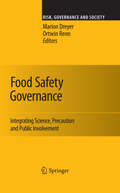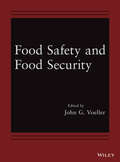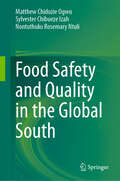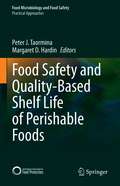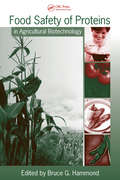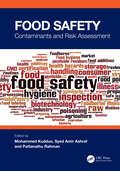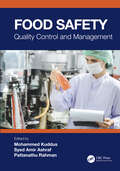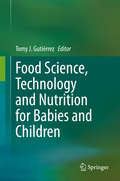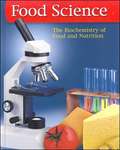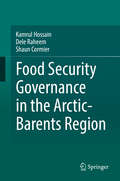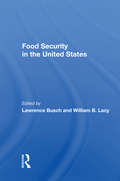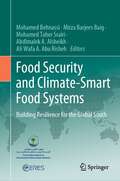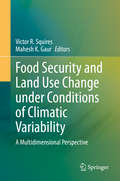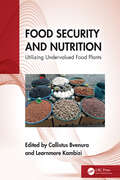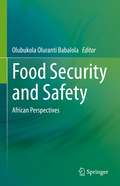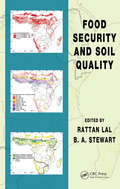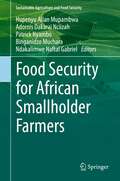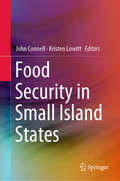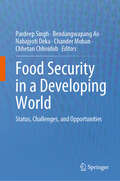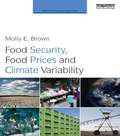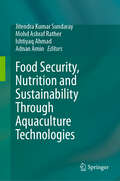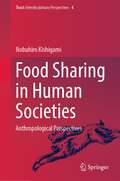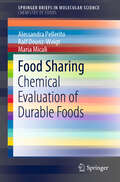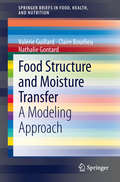- Table View
- List View
Food Safety Governance
by Ortwin Renn Marion DreyerThis book offers a detailed analysis and a set of carefully measured suggestions towards achieving greater integration of science, precaution, and public involvement in current arrangements for European food safety governance. The devised governance framework provides a distinctive system of methodologies, participatory processes, and institutional configurations that demonstrates practical advice of how complex and conflicting food safety demands might be reconciled. At the core of the suggestions for procedural reform is a design with four governance stages (framing, assessment, evaluation, management, with participation and communication as cross-cutting activities), and an organisation into four assessment and management tracks distinguishing between risk-, precaution-, concern- and prevention-based approaches. In addition, the book suggests an innovative food safety interface structure designed to improve the politics-science-society coordination throughout the governance process.
Food Safety and Food Security
by John G. VoellerFood Safety and Food Security features articles from the Wiley Handbook of Science and Technology for Homeland Security covering topics related to processing and packaging methods to protect food supply against contamination and to mitigate the consequences of contaminated foods. It discusses related detection systems as well as decontamination and disposal of contaminated foods.
Food Safety and Quality in the Global South
by Sylvester Chibueze Izah Matthew Chidozie Ogwu Nontuthuko Rosemary NtuliThis book focuses on sustainable food systems in the Global South as highlighted by the United Nations Sustainable Development Goal 2, which seeks to end global hunger through food and nutrient security. It addresses the organoleptic properties of food that contribute to food quality as well as aspects of food safety such as the systematic handling, preparation, packaging, contamination, and storage within the food system to ensure food quality is maintained while preventing food-borne illnesses. The book assesses the state of food quality in the Global South and promotes the establishment of critical control points for food quality monitoring and maintaining adequate nutrient levels in food while keeping out organic, inorganic, and synthetic contaminants. The book also contains recommendations for corrective actions, including consumer information systems and remedial health actions. The book systematically connects food safety and quality in the Global South with broader health and sustainable development implications, including the rising concern of non-communicable diseases. This comprehensive book delves into various aspects of food safety and quality in the Global South, offering insights into challenges, solutions, and emerging trends across multiple disciplines. This book serves as a valuable resource for academics, researchers, policymakers, and practitioners involved in food science, public health, and sustainable development. The diverse range of topics covered contributes to a holistic understanding of the complexities involved in ensuring safe and high-quality food in the unique context of the Global South.
Food Safety and Quality-Based Shelf Life of Perishable Foods (Food Microbiology and Food Safety)
by Peter J. Taormina Margaret D. HardinThis book addresses the shelf life of foods, a key factor in determining how food is distributed and consequently where and when different food products are available for consumption. Shelf life is determined by several factors, including microbiological, chemical, physical, and organoleptic deterioration. Often these factors are interrelated and interdependent. The editors of this volume focus specifically on the microbial factors related to shelf life of perishable foods and food commodities. This allows for more detailed coverage of foodborne bacterial pathogens and spoilage microorganisms of concern. The initial part of the book covers the why and how of shelf life determination as well as the specific microbial pathogens and spoilage microorganisms of concern for perishable foods. Contributors address topics such as the techniques utilized for determination of shelf life, the frequency of shelf life testing for different products, the interpretation of data to make shelf life determinations, and management of shelf life of food products from the perspective of the food producer, distributor, retailer, and regulator. Three key areas impacting shelf life are addressed in detail: sanitation, processing, and packaging. The sanitation chapter explains the necessary components of cleaning and sanitizing to assure a hygienic processing environment and why that is critical to shelf life control. Traditional processing procedures are reviewed and advanced processing technologies are explored. Materials used in food packaging and the utilization of traditional and activated food packaging by product type are covered in detail. The latter two chapters of the book delve into newer techniques of analysis and explore the microbiome of food products. Implications of microbial ecology and microbial quantification in food products are discussed in chapters on genomics and in the changing dogma of meat shelf life. The primary audience for this work includes food industry quality and food safety technicians, managers, directors, and executives responsible for shelf life. Academicians and governmental researchers involved in research and teaching about food safety and quality will also find the material relevant and useful.
Food Safety of Proteins in Agricultural Biotechnology (ISSN)
by Bruce G. HammondWith contributions from internationally recognized experts, Food Safety of Proteins in Agricultural Biotechnology comprehensively addresses how toxicology testing of proteins should be accomplished and how protein safety assessments should be carried out. Beginning with a background on protein biology, the book delineates the fundamental difference
Food Safety: Contaminants and Risk Assessment
by Mohammed Kuddus Syed Amir Ashraf Pattanathu RahmanFood Safety: Contaminants and Risk Assessment is a state-of-art reference on food safety, which is the biggest challenge in the food supply chains worldwide. Despite advancements in hygiene, food treatment, and food processing, foodborne pathogens or food contaminants still represent a significant threat to human health. This book presents comprehensive information about the major food contaminants across food types. The text provides facts about setting up food safety initiatives and safety rules, foodborne pathogen detection, production and processing compliance issues, and safety education.Key Features Examines a diverse range of contaminants across food types Describes various food allergens and allergies Discusses contamination in drinking water and bottled water Reviews the international regulations for management of food hazards Throws light on the overall impact of food safety of global food supply chains This book is meant for postgraduate students, researchers, and food industry professionals.
Food Safety: Quality Control and Management
by Mohammed Kuddus Syed Amir Ashraf Pattanathu RahmanThis book is an updated reference source on food safety best practices. The chapters discuss analytical approaches to measuring food contaminants, quality control and risk assessment of food storage, food irradiation, etc. The contributors discuss how quality control and management help to establish sustainable and secure food systems globally. The book covers topics such as techniques to measure food contaminants, toxins, heavy metals and pesticide content in food.FEATURES Examines the role of food safety approaches in global food supply chains Describes various detection techniques for food contaminants and toxins Discusses the application of nanotechnology and other innovations in food safety and risk assessment Reviews the international regulations for management of food hazards Includes the hazard analysis critical control points (HACCP) principles This book is an essential resource to help students, researchers, and industry professionals understand and address day-to-day problems regarding food contamination and safety and their impact on human health.
Food Science, Technology and Nutrition for Babies and Children
by Tomy J. GutiérrezInfants and children are regularly fed with processed foods, yet despite their importance in human development, these foods are rarely studied. This important book provides an exhaustive analysis of key technologies in the development of foods for babies and children, as well as the regulation and marketing of these food products. Contributors cover different aspects of food science and technology in development of baby foods, making this text an unique source of information on the subject. Food Science, Technology, and Nutrition for Babies and Children includes relevant chapters on infant milk formulas, essential fatty acids in baby foods, baby food-based cereals and macro- and micronutrients. This book also offers alternatives from the point of view of food technology for babies and children with special diet regimes associated to metabolic or enzymatic diseases such as allergy to casein, phenylalanine (phenylketonuria or commonly known as PKU) and gluten (celiac disease), or lactose intolerance. This book also addresses some nutritional aspects of babies and children in terms of the childhood obesity, child’s appetite and parental feeding. With its comprehensive scope and up-to-date coverage of issues and trends in baby and children’s foods, this is an outstanding book for food scientists and technologists, food industry professionals, researchers and nutritionists working with babies and children.
Food Science: The Biochemistry of Food and Nutrition
by Kay Yockey Mehas Sharon Lesley RodgersIn Food Science: The Biochemistry of Food and Nutrition students learn to use the scientific method as they study the biological and chemical basis of food and nutrition. The text combines scientific principles with real-life applications of food preparation and nutrition. It is taught by the Family and Consumer Sciences teacher, a Science teacher, or by the two together. Students will learn to apply scientific principles of food and nutrition as they explore foods and nutrition using basic scientific equipment. Measurement, use of equipment, problem solving, reasoning skills and writing are emphasized. This flexible text format is adaptable to a one or two semester course.
Food Security Governance in the Arctic-Barents Region
by Kamrul Hossain Dele Raheem Shaun CormierFood Security Governance in the Arctic-Barents Region provides a multidisciplinary perspective on the major food security and safety challenges faced in the Arctic region. The authors address existing gaps in current knowledge of the coordination and implementation of legal framework and policy that affects the Arctic. The volume is unique in its focus on the Barents region, an area of northern Europe containing Norway, Sweden, Finland and Russia. The region has a population of approximately 5.2 million, including indigenous and non-indigenous peoples. The authors offer a balanced and systemic review of the role of traditional foods in this region, along with an overview of the regulatory tools and institutions that govern food security. Food security and safety in the –Arctic-Barents region is connected to and impacted by transformations from both inside and outside the area. Climate change, globalization and human activities affect the availability, accessibility, and affordability of food. The result of these transformations has an impact on the food security and safety for both indigenous and non-indigenous individuals and communities. The authors, by highlighting these challenges, reveal the importance of having harmonized policies and legal tools in place in order to strengthen food security and safety in the Barents region. The book forms part of the main outcome of the Academy of Finland’s ongoing project on Human Security as a promotional tool for societal security in the Arctic: Addressing Multiple Vulnerability to its Population with Specific Reference to the Barents Region (HuSArctic). Researchers, policy makers, and other stakeholders will find the book to be an important contribution to the promotion of policies and strategies on food security.
Food Security In The United States
by William B. Lacey Lawrence M. BuschDespite the fact that every year it produces a larger surplus of agricultural products than any other country in the world, the U.S. still must contend with a number of important but often unaddressed issues related to food security, including problems of soil erosion, water supply, energy availability, nutrition; farm worker health and safety, and product distribution. This book; containing contributions from authorities in both the natural and social sciences, expands the range of issues pertinent to the security of the U.S. food system, taking into account the adequacy and sustainability of the food supply, equity in access to food by the entire population, the nutritional quality of food, and the costs and benefits (social, economic, and health) of the food system as it is presently organized. Each of the authors considers an aspect of U.S. food security from the point of view of a specific discipline, as well as in terms of broader policy implications.
Food Security and Climate-Smart Food Systems: Building Resilience for the Global South
by Mohamed Behnassi Mirza Barjees Baig Mohamed Taher Sraïri Abdlmalek A. Alsheikh Ali Wafa A. Abu RishehThe resilience of food systems and security to emerging challenges and threats, especially in the context of environmental and climate risks and global pandemics such as the Covid-19 crisis, is currently gaining growing importance in research, policy, and practice. Based on this, the core focus of this book, as a part of a series of CERES publications, consists of identifiying and exploring the best ways to overcome such challenges and shocks and to build resilience in the Global South. More precisely, the book analyzes current dynamics and trends related to the climate resilience of food security and assess the relevance of emerging approaches such as climate-smart agriculture, new roles of agriculture extension, smart farming, and climate adaptation of farming systems.The book includes both conceptual and empirical research reporting lessons learned from many geographical, environmental, social, and policy settings while focusing on Africa, Middle East, and Asia. It also provides research and policy-oriented inputs and recommendations to guide change processes at multiple scales.
Food Security and Land Use Change under Conditions of Climatic Variability: A Multidimensional Perspective
by Victor R. Squires Mahesh K. GaurThis volume analyzes the global challenges of food security, land use changes, and climate change impacts on food production in order to recommend sustainable development policies, anticipate future food services and demands, and identify the economic benefits and trade-offs of meeting food security demands and achieving climate change mitigation objectives. The key points of analysis that form the conclusions of this book are based on measuring the quantity and quality of land and water resources, and the rate of use of sustainable management of these resources in the context of socio-economic factors, including food security, poverty, and climate change impacts. In six parts, readers will learn about these crucial dimensions of the affects of climate change on food security, and will gain a better understanding of how to assess the trade-offs when combating multiple climate change challenges and how to develop sustainable solutions to these problems. The book presents multidimensional perspectives from expert contributors, offering holistic and strategic approaches to link knowledge on climate change and food security with action in the form of policy recommendations, with a focus on sociological and socio-economic components of climate change impacts. The intended audience of the book includes students and researchers engaged in climate change and food security issues, NGOs, and policy makers.
Food Security and Nutrition: Utilizing Undervalued Food Plants
by Learnmore Kambizi Callistus BvenuraFood Security and Nutrition: Utilizing Undervalued Food Plants explores the potential of underutilized and indigenous food plants to enhance food and nutrition security amid global challenges, such as climate change, water scarcity, and population growth. It emphasizes the importance of dietary diversification to reduce dependency on major staple crops, highlighting the nutritional and health benefits of lesser-known crops, such as fonio, pigeonpea, finger millet, and a wide array of wild vegetables and mushrooms. The book reviews innovative farming techniques, like the organic medium–enclosed trough system and hydroponics, which improve crop yield and nutrient content while conserving resources. Additionally, it addresses the commercialization potential of indigenous fruits and wild herbal teas, emphasizing their market value and health benefits. The book also discusses the reduction of goitrogenic compounds in certain crops to mitigate health risks.By examining the unique nutritional profiles and local adaptability of these crops, the book advocates for their broader use to build a more resilient and sustainable food system. Through a combination of scientific research, practical farming methods, and market strategies, the book aims to promote food diversity, improve health outcomes, and support sustainable agricultural practices.Key Features Highlights the critical role of dietary diversification in reducing dependency on major staple crops, advocating for the inclusion of lesser-known, nutrient-rich plants to improve overall health and nutrition. Introduces cutting-edge farming methods, such as the organic medium–enclosed trough system and hydroponics. Explores the market value and health benefits of indigenous fruits and wild herbal teas, offering strategies for their commercialization to boost local economies and food security. Addresses the reduction of harmful compounds, and provides practical solutions to mitigate associated health risks and enhance the safety of food consumption.
Food Security and Safety: African Perspectives
by Olubukola Oluranti BabalolaThis book focuses on food security and safety issues in Africa, a continent presently challenged with malnutrition and food insecurity. The continuous increase in the human population of Africa will lead to higher food demands, and climate change has already affected food production in most parts of Africa, resulting in drought, reduced crop yields, and loss of livestock and income. For Africa to be food-secure, safe and nutritious food has to be available, well-distributed, and sufficient to meet people’s food requirements. Contributors to Food Security and Safety: African Perspectives offer solutions to the lack of adequate safe and nutritious food in sub-Saharan Africa, as well as highlight the positive efforts being made to address this lack through a holistic approach. The book discusses the various methods used to enhance food security, such as food fortification, fermentation, genetic modification, and plant breeding for improved yield and resistance to diseases. Authors emphasize the importance of hygiene and food safety in food preparation and preservation, and address how the constraints of climate change could be overcome using smart crops. As a comprehensive reference text, Food Security and Safety: African Perspectives seeks to address challenges specific to the African continent while enhancing the global knowledge base around food security, food safety, and food production in an era of rapid climate change.
Food Security and Soil Quality (Advances in Soil Science)
by Paul C. H. LiJust five years ago, it was generally believed that the number of food insecure people in the world was on continuous decline. Unfortunately, widespread soil degradation along with resistance to recommended agronomic practices, and little attempt to restore degraded soils have conspired with significant droughts (in regions that could least tolerat
Food Security for African Smallholder Farmers (Sustainability Sciences in Asia and Africa)
by Hupenyu Allan Mupambwa Adornis Dakarai Nciizah Patrick Nyambo Binganidzo Muchara Ndakalimwe Naftal GabrielThis book provides a synthesis of current agricultural research in Africa with the aim of presenting evidence based information that can be directly applied into improving the African smallholder farmers’ food security. It presents positive scientific research that has been undertaken in Africa, in simpler terms, thus driving the research for development agenda contributing to the attainment of SDG 2. Numerous research that targets resource poor African smallholder farmers has been published, yet the region faces very low productivity levels. This lack of translation from research to food security and increased agricultural incomes is due to the poor uptake of scientific research by farmers, which is partly due to poor presentation of this body of knowledge into simpler forms that extension workers and farmers can directly adopt. Therefore, this book offers research information in an easy, digestible and application oriented style, so as to enable transformation of the African agricultural sector by effectively driving agricultural productivity in Africa. This book is of interest to African extension workers, who will translate the simplified knowledge into lessons that can be useful to smallholder farmers. The book is also beneficial for policy makers as well as academics, researchers and other science based professionals.
Food Security in Small Island States
by John Connell Kristen LowittThis book provides a contemporary overview of the social-ecological and economic vulnerabilities that produce food and nutrition insecurity in various small island contexts, including both high islands and atolls, from the Pacific to the Caribbean. It examines the historical and contemporary circumstances that have accompanied the shift from subsistence production to the consumption of imported, processed foods and drinks, and the impact of this transition on nutrition and the rise of non-communicable diseases. It also assesses the challenges involved in reversing this trend, and how more effective social and economic policies, agricultural and fisheries strategies, and governance arrangements could promote more resilient and sustainable small island food systems. It offers both theoretical and practical perspectives, and brings together a broad range of policy areas, e.g. agriculture, food, commerce, health, planning and socio-economic policy.Given its scope, the book offers a valuable resource for a range of disciplines in a number of regional contexts, and for the growing number of scholars and practitioners working on and in small island states. It will be of particular value as the first book to examine the diversity and commonalities of island states around the globe as they confront issues of food security.
Food Security in a Developing World: Status, Challenges, and Opportunities
by Pardeep Singh Bendangwapang Ao Nabajyoti Deka Chander Mohan Chhetan ChhoidubThe book tries to answer the most fundamental question of whether there is a link between abundant food supply and economic growth with respect to a higher degree of human development. In order to have flourishing economic growth within a country the need for a food security system is a must. The world as we know is faced with shortages of food supply which has been a major factor in the country's economic development. The book is an attempt to understand the problems and current situation of food systems in the developing world. It focuses on the pathways to understand the challenges that it faces and predict future scenarios. The motive is to create academic literature to understand the basis of sustainable food security. The social, economic, and political factors become the main theme of the book. It focuses on the interdisciplinary nature of food security. Many a time we only understand the idea of food security through the lens of scientific nature but in the meantime, it forgets the other important factors that are governing the issue of food security. The inclusion of the cases section in the book helps to outline the current scenarios of the developing world. It helps to formulate a pathway or a way forward to understand the causes of food security. Food has now become a political context in the international system. The need for analyzing the political angle is necessary. The context of innovations and technological developments forms an important part of food security. The critique of existing policy systems across the developing world is a must need discussion as it is the policies that will make the food systems sustainable. Last but not least is to look at how the global food systems work and how far it has been able to fix the problems of food insecurity in the developing world. Overall, the book is an excellent interdisciplinary food security literature.
Food Security, Food Prices and Climate Variability (Earthscan Food and Agriculture)
by Molly E. BrownThe agriculture system is under pressure to increase production every year as global population expands and more people move from a diet mostly made up of grains, to one with more meat, dairy and processed foods. This book uses a decade of primary research to examine how weather and climate, as measured by variations in the growing season using satellite remote sensing, has affected agricultural production, food prices and access to food in food-insecure regions of the world. The author reviews environmental, economics and multidisciplinary research to describe the connection between global environmental change, changing weather conditions and local staple food price variability. The context of the analysis is the humanitarian aid community, using the guidance of the USAID Famine Early Warning Systems Network and the United Nation’s World Food Program in their response to food security crises. These organizations have worked over the past three decades to provide baseline information on food production through satellite remote sensing data and agricultural yield models, as well as assessments of food access through a food price database. These datasets are used to describe the connection, and to demonstrate the importance of these metrics in overall outcomes in food-insecure communities.
Food Security, Nutrition and Sustainability Through Aquaculture Technologies
by Jitendra Kumar Sundaray Mohd Ashraf Rather Adnan Amin Ishtiyaq AhmadAquaculture is the farming of aquatic organisms such as fish, crustaceans, mollusks and aquatic plants. It is a rapidly growing industry that plays a significant role in providing food security, improving nutrition and promoting sustainability. Food security is a major global concern, with millions of people around the world suffering from malnutrition and hunger. Food security, nutrition and sustainability are global challenges that need urgent attention to achieve a better and more sustainable future. Aquaculture technologies can help to address this problem by increasing the availability and accessibility of fish and other aquatic foods, providing a source of protein-rich food, improving nutrition, enhancing sustainability, generating income and improving food safety. In addition, aquaculture technologies play an important role in promoting nutrition. Fish and other aquatic foods are a good source of essential nutrients that are important for human health, including omega-3 fatty acids, vitamin D and minerals like iron and zinc. By increasing access to these foods, aquaculture can help to improve nutrition and reduce the incidence of diet-related diseases. Fish and shellfish are rich in omega-3 fatty acids, which have been linked to improved heart health, brain function and other health benefits. By incorporating fish and shellfish into their diets, people can improve their overall nutritional intake and reduce the risk of chronic diseases. Food Security, Nutrition and Sustainability Through Aquaculture Technologies shines a light on how aquaculture technologies contribute to sustainability by providing a more efficient and environmentally friendly way of producing food. Compared to traditional fishing practices, aquaculture can reduce pressure on wild fish populations and minimize the negative impact of fishing on marine ecosystems. Additionally, advances in aquaculture technology have led to the development of more sustainable and efficient production systems, including recirculating aquaculture systems and integrated multi-trophic aquaculture. As the global population continues to grow, demand for protein-rich foods like fish is increasing. Aquaculture provides a sustainable way to meet this demand, as it can produce more protein per unit of feed than traditional livestock farming. This book discusses aquaculture practiced in areas where traditional agriculture is not feasible, such as regions that are unsuitable for crop production. In addition to providing a source of protein, aquaculture can also improve nutrition. Aquaculture can be practiced in a sustainable manner, with minimal impact on the environment. Unlike traditional fishing, which can deplete wild fish populations and damage marine ecosystems, aquaculture allows for the controlled cultivation of fish and other aquatic organisms. Properly managed aquaculture operations can also minimize waste and pollution and caneven contribute to ecosystem restoration by providing habitat for marine species. This book includes chapters on various aspects of aquaculture technologies that address a range of important global challenges including food security, nutrition and sustainability and are likely to play an increasingly important role in meeting the world's growing demand for food.
Food Sharing in Human Societies: Anthropological Perspectives (Trust #4)
by Nobuhiro KishigamiThis book explores why human beings share food with others using a humanistic anthropological approach. This book provides a comparative examination of distinct features and historical changes in food-sharing practices in various hunting-gathering societies, especially in the Inuit. The author considers human nature through various human food-sharing practices. Food sharing is a characteristic of human behavior and has been one of the central topics in anthropological studies of hunter-gatherers for a long time. While anthropologists have attempted to understand it in functional, historical, adaptational, social, cultural, psychological, or phenomenological perspective, they have failed to convincingly explain its origin, variation, existence or/and change. Recently, evolutionary ecology or behavioral ecology has dominated research of the topic. However, neither of them adequately considers social, cultural and historical factors in the analysis of human food-sharing practices. This book is an essential and fundamental study for every researcher interested in the relationship between human nature, society and culture.
Food Sharing: Chemical Evaluation of Durable Foods (SpringerBriefs in Molecular Science)
by Maria Micali Alessandra Pellerito Ralf Dounz-WeigtThis book presents the concept of food sharing from a European perspective, and provides a concise analysis of its safety implications and the chemical properties of recovered foods.In our modern world, 33% of the total food produced is lost each year, with serious economic, environmental and social consequences. Food worth approximately 1 trillion USD is wasted per year, and it is estimated that this wasted food could feed more than 3.4 billion people. Considering that 1/10 of the global population still does not have enough money for basic needs, and in view of the impact of consumer behaviour, food retailers and industry in food waste, food sharing appears to be an attractive solution, and several communities have recently been created with the main goal of saving food and giving it to those in need. Despite the positive impact of food sharing, it also raises concerns since recovered foods are subject to spoilage, decay and irreversible chemical-physical transformations.In this book, the authors explore the current situation and the regulatory definition of food sharing in various European countries, presenting the German experience in the city of Magdeburg, where food-sharing networks have been implemented. They also discuss the chemical and safety evaluations of durable foods, and provide a simulation of food waste by comparing a food product with the same food produced with re-worked and still edible raw materials (recovered foods).
Food Structure and Moisture Transfer
by Nathalie Gontard Valérie Guillard Claire BourlieuIt's well known that the structural characteristics of food materials influence their mass transfer, especially their water transfer properties during such processes as drying, hydration, and storage. In porous cereal-based products, for example, effective water diffusivity is highly affected by the volume fraction and distribution of both solid and gas phases, while in dense food materials, such as fat-based or other edible coatings, it depends on factors that affect the "tightness" of the molecular structure (e.g., free volume, cohesive energy density, crystallinity). This Brief will review the impact of food structure on moisture transfer. A multi-scale analysis of food structure will include a look at molecular structure (e.g., free volume, crystallinity), nanostructure, microstructure (e.g., porous food), and macrostructure (e.g., bilayer structure). For each structural analysis, a focus on the mathematical modelling of the relationship between structural properties and moisture transfer properties will be performed.
